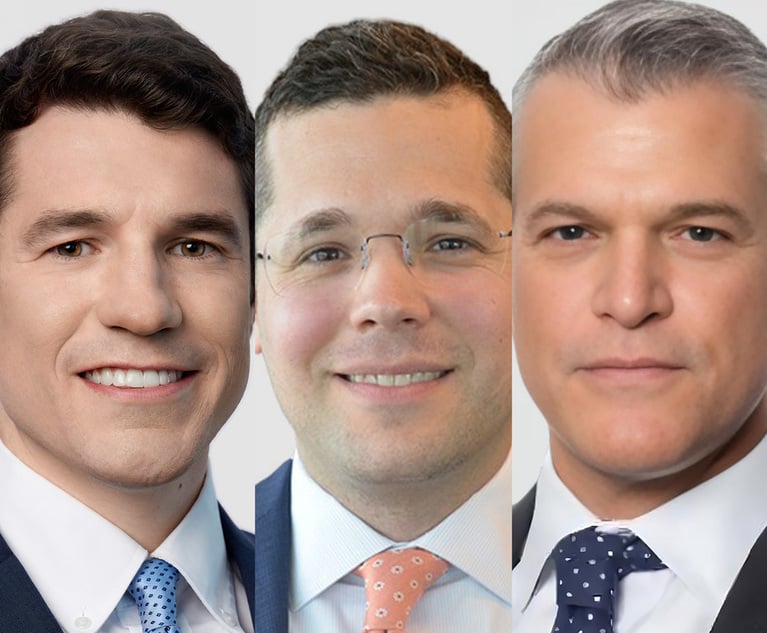Working With #Influencers: What Businesses Need to Know
The informal nature of social media, however, makes it easy to overlook the legal implications of utilizing influencer marketing.
June 20, 2019 at 10:00 AM
6 minute read
 (L to R) Katherine Califa senior counsel Washington, DC and Laura Ganoza partner, Miami Foley & Lardner (Photo: Courtesy Photo) .
(L to R) Katherine Califa senior counsel Washington, DC and Laura Ganoza partner, Miami Foley & Lardner (Photo: Courtesy Photo) .
Businesses are spending billions of dollars a year to reach the loyal followers of “social media influencers.” Whether this means sending a free product to an influencer asking that she post a video review on YouTube or paying an influencer to post photographs of a company's product on Instagram—businesses are spending big money to tap into the perceived authenticity, credibility and social network of influencers.
The informal nature of social media, however, makes it easy to overlook the legal implications of utilizing influencer marketing.
But It's Just a Post on Social Media
Let's be clear: a social media or blog post by a company, or at the direction of a company, is a form of advertising. Thus, all the legal regulations applicable to traditional forms of advertising are applicable to social media posts by companies and by the influencers they engage.
The Federal Trade Commission (FTC) is the federal agency tasked with protecting consumers from unfair and deceptive practices in the marketplace. It has published endorsement guides that provide direction to brand owners and influencers about social media advertising. Businesses would be wise to adhere to the FTC endorsement guides. Running afoul of the FTC exposes brand owners to cease and desist orders, fines, mandated customer refunds, corrective advertising obligations and other penalties.
In 2016, national retailer Lord & Taylor settled with the FTC after failing to disclose that certain influencers' posts displaying the Lord & Taylor's Design Lab fashion collection were actually paid promotions. Lord & Taylor allegedly paid 50 influencers to post Instagram photos of themselves in the same paisley dress and tag the corporate social media account @lordandtaylor. The posts reached over 11.4 million Instagram users in two days. This marketing campaign led to 328,000 brand engagements with Lord & Taylor and caused the dress to sell out.
In April 2017, the FTC went on a campaign to educate influencers and brands about their duties to include clear and conspicuous material disclosures in social media posts. The FTC sent out more than 90 letters to influencers and brands questioning whether a material connection existed between the brand and the influencer. This campaign signaled that the FTC was serious about enforcing its guidelines.
Also in September 2017, the FTC settled its first-ever complaint against individual social media influencers. The FTC charged two gaming influencers, Trevor “TmarTn” Martin and Thomas “Syndicate” Cassell, with false and deceptive advertising for posting tweets such as “I lied … I didn't turn $200 into $4,000 on @CSGOLotto … I turned it into $6,000!!!!” without disclosing that they were co-owners of the game being advertised. The FTC complaint also alleged that Martin and Cassell paid other gamers to post in their social media circles about their experiences playing the CSGO Lotto game—but prohibited the influencers from making any negative statements about CSGO Lotto. The FTC charged that these posts did not reflect the independent opinions of impartial users and the influencers failed to disclose the material connections they had to the company. The parties reached a settlement with the FTC in which they agreed to make changes to their advertising practices, establish a system that monitors, reviews, and reports all endorsers' online videos and social media postings, and make periodic reports to the FTC, among other terms.
Best Practices For Brand Owners
While using influencers to market a product can be very effective, brand owners must be careful to avoid an FTC violation. Companies should ensure their influencer marketing campaigns comply with FTC requirements. Brand owners should also educate the influencers they work with and proactively monitor their adherence to FTC guidelines. Here are some best practices for brand owners to convey to their influencers.
- Disclose all “material connections.” These include:
- Financial relationships, such as cash payments, free or discounted products or services, gifts or other benefits (equity/ownership interest, credits, royalties, VIP/priority access, cross promotional efforts, etc.);
- Familial relationships, such as posting about a sibling's or in-law's product; and
- Corporate relationships, such as posting about an employer.
- All disclosures must be “clear and conspicuous.”
- Although some social media platforms have embedded disclosure notification tools, these may not be sufficient.
- Do not bury disclosures in a “more” link, at the bottom of a blog post, or in a bunch of hashtags.
- Space constraints are no excuse for inadequate disclosures.
- For platforms where space is not an issue (e.g., Facebook, YouTube), include simple statements like “'Brand' gave me this product to try …” or “'Brand” paid me to review this …” at the beginning of the post or video.
- For platforms with space constraints (e.g., Twitter, Instagram), place unambiguous tags such as ad, sponsored, paid ad, or promotion in a location that is hard to miss.
- For ephemeral platforms (e.g., Snapchat, Instagram stories), superimpose the disclosure over the images. The disclosure should be easy to notice and easy to read in the time that people would have to look at the page.
- For video promotions, make the disclosure at the beginning of a video. A disclosure that appears only at the end of the video or in the video description text is likely insufficient.
- Treat each post as a standalone advertisement. Each and every social media post should contain clear and conspicuous disclosures. A consumer may encounter a post in a vacuum (for example, if it has been reposted by a third party), and thus influencers cannot rely on disclosures in prior posts—even those published on the same day.
Laura Ganoza is a Miami partner and Katherine Califa is Washington, D.C., senior counsel with Foley & Lardner.
This content has been archived. It is available through our partners, LexisNexis® and Bloomberg Law.
To view this content, please continue to their sites.
Not a Lexis Subscriber?
Subscribe Now
Not a Bloomberg Law Subscriber?
Subscribe Now
NOT FOR REPRINT
© 2025 ALM Global, LLC, All Rights Reserved. Request academic re-use from www.copyright.com. All other uses, submit a request to [email protected]. For more information visit Asset & Logo Licensing.
You Might Like
View All
Initial Steps to Set Up a Fla. Appeal: Your Future Self (or Appellate Attorney) Will Thank You
6 minute read
Divorce Timing Is Everything: Waiting for the New Year May Have Its Advantages
4 minute read
Motions for Summary Judgment and Discovery: The 2021 Rule Changes Continue to Emerge
5 minute read
Trending Stories
- 1Many LA County Law Firms Remain Open, Mobilize to Support Affected Employees Amid Historic Firestorm
- 2Stevens & Lee Names New Delaware Shareholder
- 3U.S. Supreme Court Denies Trump Effort to Halt Sentencing
- 4From CLO to President: Kevin Boon Takes the Helm at Mysten Labs
- 5How Law Schools Fared on California's July 2024 Bar Exam
Who Got The Work
Michael G. Bongiorno, Andrew Scott Dulberg and Elizabeth E. Driscoll from Wilmer Cutler Pickering Hale and Dorr have stepped in to represent Symbotic Inc., an A.I.-enabled technology platform that focuses on increasing supply chain efficiency, and other defendants in a pending shareholder derivative lawsuit. The case, filed Oct. 2 in Massachusetts District Court by the Brown Law Firm on behalf of Stephen Austen, accuses certain officers and directors of misleading investors in regard to Symbotic's potential for margin growth by failing to disclose that the company was not equipped to timely deploy its systems or manage expenses through project delays. The case, assigned to U.S. District Judge Nathaniel M. Gorton, is 1:24-cv-12522, Austen v. Cohen et al.
Who Got The Work
Edmund Polubinski and Marie Killmond of Davis Polk & Wardwell have entered appearances for data platform software development company MongoDB and other defendants in a pending shareholder derivative lawsuit. The action, filed Oct. 7 in New York Southern District Court by the Brown Law Firm, accuses the company's directors and/or officers of falsely expressing confidence in the company’s restructuring of its sales incentive plan and downplaying the severity of decreases in its upfront commitments. The case is 1:24-cv-07594, Roy v. Ittycheria et al.
Who Got The Work
Amy O. Bruchs and Kurt F. Ellison of Michael Best & Friedrich have entered appearances for Epic Systems Corp. in a pending employment discrimination lawsuit. The suit was filed Sept. 7 in Wisconsin Western District Court by Levine Eisberner LLC and Siri & Glimstad on behalf of a project manager who claims that he was wrongfully terminated after applying for a religious exemption to the defendant's COVID-19 vaccine mandate. The case, assigned to U.S. Magistrate Judge Anita Marie Boor, is 3:24-cv-00630, Secker, Nathan v. Epic Systems Corporation.
Who Got The Work
David X. Sullivan, Thomas J. Finn and Gregory A. Hall from McCarter & English have entered appearances for Sunrun Installation Services in a pending civil rights lawsuit. The complaint was filed Sept. 4 in Connecticut District Court by attorney Robert M. Berke on behalf of former employee George Edward Steins, who was arrested and charged with employing an unregistered home improvement salesperson. The complaint alleges that had Sunrun informed the Connecticut Department of Consumer Protection that the plaintiff's employment had ended in 2017 and that he no longer held Sunrun's home improvement contractor license, he would not have been hit with charges, which were dismissed in May 2024. The case, assigned to U.S. District Judge Jeffrey A. Meyer, is 3:24-cv-01423, Steins v. Sunrun, Inc. et al.
Who Got The Work
Greenberg Traurig shareholder Joshua L. Raskin has entered an appearance for boohoo.com UK Ltd. in a pending patent infringement lawsuit. The suit, filed Sept. 3 in Texas Eastern District Court by Rozier Hardt McDonough on behalf of Alto Dynamics, asserts five patents related to an online shopping platform. The case, assigned to U.S. District Judge Rodney Gilstrap, is 2:24-cv-00719, Alto Dynamics, LLC v. boohoo.com UK Limited.
Featured Firms
Law Offices of Gary Martin Hays & Associates, P.C.
(470) 294-1674
Law Offices of Mark E. Salomone
(857) 444-6468
Smith & Hassler
(713) 739-1250






